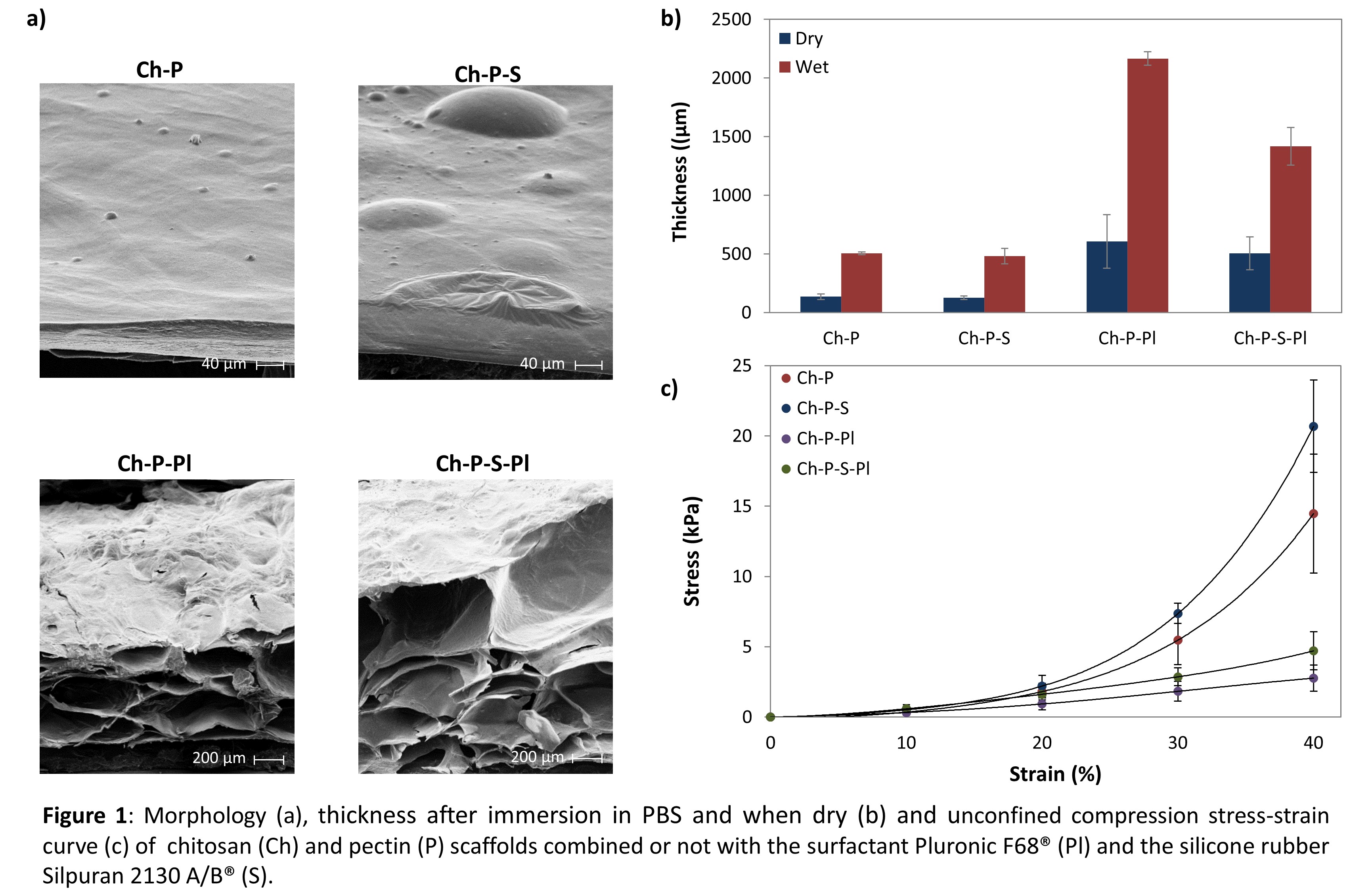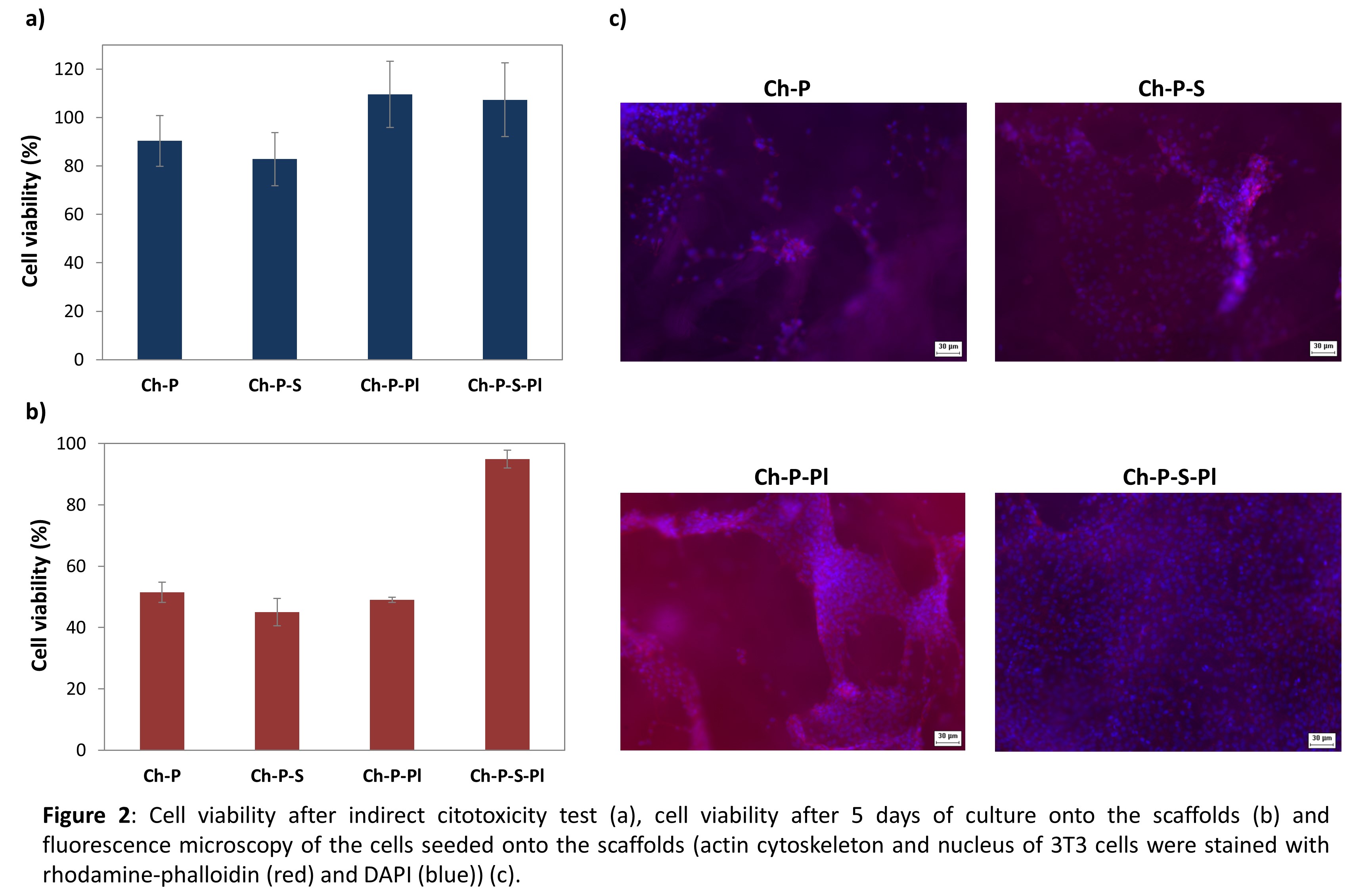Introduction: Scaffolds, as supports for cell growth, should present appropriate porosity and mechanical properties[1],[2]. In this work, the polysaccharides chitosan (Ch) and pectin (P) were combined in the presence of the surfactant Pluronic F68® (Pl) to obtain porous biocompatible scaffolds. However, the presence of pores in the matrices worsens their mechanical properties and the use of a strategy to promote mechanical reinforcement is necessary, thus, the silicone rubber Silpuran 2130 A/B® (S) was added to the formulations. Fibroblasts were seeded onto dense and porous scaffolds, containing or not the silicone, and their viability was analyzed as a function of the materials porosity and stiffness.
Materials and Methods: Ch-P scaffolds containing or not 10% (w/w) Pl and S were prepared by solvent casting. CaCl2 and NaOH were used for crosslinking and pH neutralization. Morphology was analyzed by scanning electron microscopy. Thickness of dry samples was measured using a micrometer. Mechanical behavior was assessed by stress relaxation in unconfined compression tests and the equipment measured the thickness of samples immersed in phosphate-buffered saline. Indirect cytotoxicity tests were performed by exposing 3T3 cells (fibroblasts) to extracts of the scaffolds in culture medium. 3T3 cells were seeded onto 8 mm diameter samples at 4x104 cells/cm2 and viability was assessed after 5 days.
Results and Discussion: Ch-P samples containing Pl present high porosity (Fig. 1a). Pore size ranges from 200 to 600 μm, adequate for cell culture[2]. Bubbles were detected throughout the structure of samples with S due to the introduction of the elastomer[3]. Thickness of samples increase about 4 times when exposed to PBS (Fig. 1b). Stress-strain curves indicate that dense formulations have higher residual stresses after relaxation, being stiffer than porous matrices (Fig. 1c). Also, the addition of silicone increases the stiffness of both types of samples. Viability of cells exposed to extracts of the scaffolds remain around 100% for all formulations, indicating that they are non-cytotoxic (Fig. 2a). Fibroblasts viability 5 days after seeding onto the scaffolds (Fig. 2b,c ) is higher for the formulation containing both Pl and S, due to the combination of the effects of both additives. The presence of pores allows the migration of cells and nutrients into the matrix and facilitate cell proliferation[2]. The presence of S, making the porous matrix stiffer, may also collaborate to cell performance as most cell types (including fibroblasts) spread well and adhere better to harder matrices[4].


Conclusion: The addition of S to dense and porous Ch-P matrices improved their mechanical properties. Preliminary results of fibroblasts culture showed that cells respond better to the porosity and stiffness of Ch-P-S-Pl. Further studies will be done regarding cell behavior onto these scaffolds as they present adequate properties for applications in tissue engineering.
FAPESP-Brazil; CAPES-Brazil; CNPq-Brazil; ELAP-Canada; NSERC-Canada; CIHR-Canada; CFI-Canada; FRQ-NT-Quebec; MRI-Quebec
References:
[1] Keane, T. J.; Badylak, S. F. Semin. Pediat. Surg. 2014, 23, 112-118.
[2] Ikada, Y. J. Roy. Soc. Interface. 2006, 3, 589-601.
[3] Pires, A. L. R.; Moraes, A. M. J. Appl. Polym. Sci. 2015, 1-9.
[4] Solon, J.; Levental, I.; Sengupta, K.; Georges, P. C.; Janmey, P. A. Biophys. J. 2007, 93, 4453-4461.